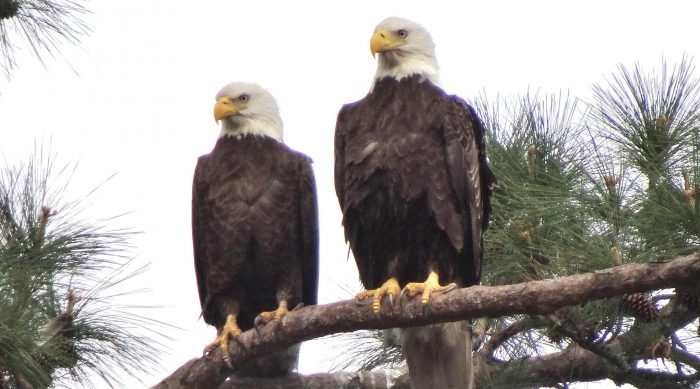EARTH DAY: The American bald eagle’s return to Long Island
By Patricia Paladines and Peter Martin
A few of months ago my husband and I received a text message from one of our neighbors, “There’s a bald eagle at the top of one of your trees.” At the time we were in our car a few miles away from our home on Main Street in Setauket.
Bald eagle sightings are becoming more common on Long Island, and we have seen a couple flyover our home in the past, but have never knowingly had one grace over our yard. We were delighted, but also concerned. Our hens were free ranging around our house as they usually do. Was this eagle assessing whether one of our 5 girls was going to be their next meal? The neighbor texted a phone photo — a representative of the United States’ national symbol sat atop one of our red cedars looking like a tree-topper on a Christmas tree. We drove into our driveway shortly after the photo was sent but the eagle had already flown away. Our first instinct was to search for our hens and count them. They were all there. No birds were harmed on this day.
The American bald eagle became our national symbol in June of 1782 when Charles Thomson, then secretary of Congress, decided to incorporate the bird into William Barton’s design for the Great Seal of the United States. As the seal began to appear on official documents, flags, currency, and public buildings the bald eagle became an American icon, representing the strength and freedom of a fledging nation.
Despite its newfound public celebrity, the bald eagle was not appreciated by farmers in the 19th century. They believed the birds to be villains who killed their livestock, even spreading strange myths that the raptors were capable of carrying away helpless human babies. In reality, bald eagles can only lift a maximum of 5 pounds, so yes, maybe a chicken as my husband and I feared, but not most domesticated mammals living on early American farms. Their habit of scavenging probably made them scapegoats for killings perpetrated by predatory mammals. The unjust accusation caused the decline of their populations across the country.
It is estimated that in the early 1800’s there were 400,000 American bald eagles across their range which extends north from the Mexican border, throughout the United States, and into Canada. Later that century their numbers had decreased to around 100,000 due to hunting and destruction of their preferred habitat, forested area near large bodies of water; habitat similar to what was found on Long Island before settlers arrived and cleared forests for farming, cordwood and construction of homes and ships.
Bald eagles were originally not protected by the Migratory Bird Treaty Act of 1918 because it was falsely believed that the birds did not migrate. In 1940 Congress passed the Bald and Golden Eagle Protection Act providing full protection to our iconic bird of prey. At around the same time the birds were granted full protection the use of the synthetic pesticide known as DDT (dichlorodiphenyltrichloroethane) became popular for use on farms and mosquito-ridden marshes, but it took some time before it was understood how this pesticide would affect the lives of many of our country’s predatory birds, including the bald eagle. By 1963, the population of eagles reached its lowest point with an estimated 417 breeding pairs of bald eagles in the lower 48 states. In the 1970’s it was estimated that there were two bald eagles left in New York state. They seemed to have completely disappeared from Long Island, along with the peregrine falcons and beloved ospreys.
It was a Brookhaven Town resident, Dennis Puleston, who first noted the decline of ospreys on Long Island. He had been studying a large breeding colony of the birds—also known as fish hawks—on Gardiners Island. He shared his concern with members of the Brookhaven Town Natural Resource Committee (BTNRC), founded in 1966 by group of environmentally minded individuals that met at an adult marine biology class taught by Art Cooley at Bellport High School. The group included Stony Brook University professors Robert Smolker and Charles Wurster.
Informed by Rachel Carson’s book, Silent Spring, the group analyzed osprey eggshells and found that DDT weakened the shells so much that they would easily crack and prevent the embryos from developing into chicks. Puelston and the others from BTNRC testified in a class action suit, initiated by Victor Yannacone, Jr., a feisty Long Island attorney, demanding the ban of DDT usage across Suffolk County.
The case was originally dismissed but the group persisted, successfully having DDT banned across Suffolk County in 1967, New York state in 1970 and nationwide in 1972. Their unique approach to environmental issues, suing the government for protection of the environment, led to the group’s founding of the Environmental Defense Fund. Their first office was located behind the mechanical eagle that adorns the front of the Stony Brook Village post office.
Ospreys have now been a familiar sight around Long Island for many years, returning from their wintering grounds in mid-March, raising young, and leaving the island again in the fall. Eagles are following on their wings, sometimes even taking over osprey nests. There are now over 8 known bald eagle nest on the island.
The memory of the appearance of an American bald eagle atop our Eastern Red Cedar on Setauket’s Main Street, where it is said that George Washington walked when he came to thank the members of the Setauket Spy Ring, seems like a beautiful way to celebrate Earth Day and the conservation successes initiated by small groups of people who care.
About the authors:
Patricia Paladines is an Adjunct Instructor at Stony Brook University’s School of Marine and
Atmospheric Sciences, as well as a photographer.
Peter Martin is a graduate student in the Marine Conservation and Policy Program at Stony
Brook University.







